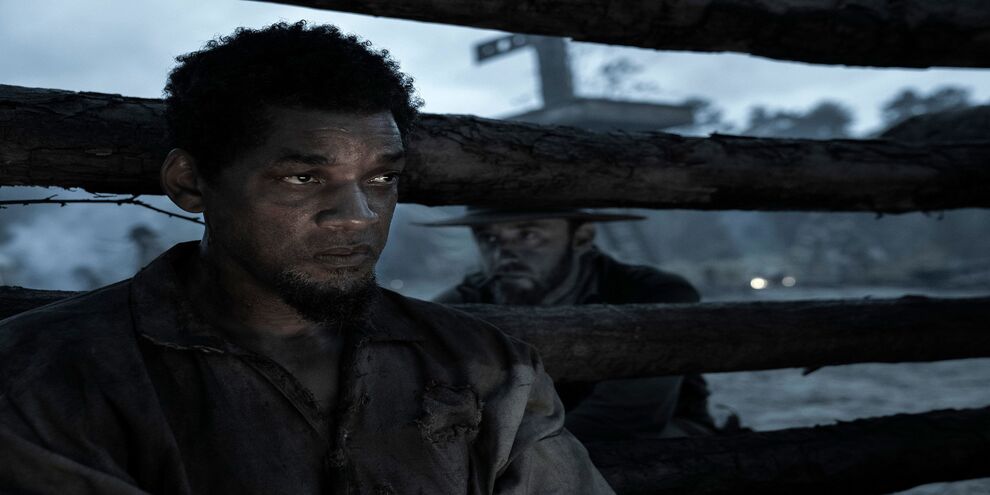The Civil War is raging, and the Confederate army can no longer hold back the advance of the North. There is only one way out: to enlist Louisiana’s slaves to work for the army. Physically strong men belonging to local slave owners are forcibly placed in special camps to build railroads.
One of these men is African-American Peter (Will Smith), separated from his family. He is a born leader. Despite the mortal danger, the unruly Peter stands up for the other slaves and bravely endures any bullying. One day he overhears the overseers discussing and condemning Lincoln’s decision to free all the slaves.
This triggers a call to action for him – Peter and several other slaves stage a riot and march through the woods and swamps to meet the Army of the North. The bloodthirsty fugitive hunter Fassel (Ben Foster), who fancies himself a god, is in pursuit of them.
The true story of a runaway slave named Gordon, on which ” Emancipation ” is based, was proof of the cruelty of American slavery and gave its opponents a symbol. The picture of the former slave’s naked back, known as “Peter Carved,” went viral across the country and once again motivated the abolitionist movement to end slavery as quickly as possible.
According to Antoine Fuqua, who directed the film, the story, in the format of Bill Collage’s script, “touched his heart and soul in a myriad of ways that are impossible to convey.” He, a stalwart genre craftsman known for “Training Day” and “The Great Equalizer,” attempted to transfer his feelings to the screen in a surprising form – half monochrome, half dull color film with dynamic color correction.
The visual is definitely the main virtue of Emancipation. Together with Robert Richardson, three-time Oscar winner and cinematographer of Martin Scorsese and Quentin Tarantino, Fuqua decides to experiment. The film’s black-and-white palette is interspersed with occasional not-so-bright colors: green foliage and burning fire give rise to color antonymity.
The slo-mo effect is used extensively, which, on the one hand, naturally destroys the peaceful flow of time, and on the other, emphasizes the posterity of Fuqua’s statement – there are enough loud words, proud looks and scenes, as if specially drawn for history textbooks.
The demonstration of violence also has an important role to play in Emancipation. Brutality is especially abundant in the first part of the picture – it is in it Fuqua fills with a reserve for the duty scale of films about slavery. Beheadings, bodies torn apart by dogs, executions, numerous lashes – the river of violence against slaves rushes onto the screen and destroys almost everything in its path.
This is exactly what Peter is running away from. One thought beckons him, one sudden hope that freedom is out there. If he has to choose between diving into a swamp with alligators on his way to freedom or facing the hounds of his pursuer, he will no doubt choose the former – a glimmer of light is more pleasant than pitch-black darkness. Even in this darkness, though, the faithful Peter does not forget to turn to the light, to the God who “loves him.
There is not a hint of halftone in the film. This applies both to the eternal American questions about slavery, to which Fuqua’s answers are unambiguous, and to the director’s genre wanderings. «Emancipation,” claiming the proud title of auteur cinema, doesn’t try to fit anywhere between genres at all – instead, it consistently jumps from one to the other.
The conclusion is a drama about the search for God, justice and freedom under inhumane conditions. Then one big story of a downtrodden people is reduced to a personal story of a confrontation between a seasoned slave hunter and a strong-minded man who embodies an unbridled eagerness for freedom.
At this point, the film turns into a Western and becomes a kind of Survivor, only in reverse: the main character is running from his adversary rather than chasing him, Will Smith, as Leonardo DiCaprio, demonstrates survival skills in the wild and even fights a huge beast. Instead of a bear here, it’s an alligator.
Approaching the denouement again becomes a trigger for a change of genre. Crossing the tangible boundary between the new world and the old, Peter quickly realizes that the change he was so eager to make is in fact illusory: there was never any mutual trust, and his choice is as bad as ever – escape death by betraying himself, or go ahead with a huge risk and a ghostly hope.
At the morality junction, he once again decides to choose hope. The film dramatically forgets that it was once a western and briefly retrains itself as a war drama. Fuqua has not much experience in this genre, which is why his film drops a lot of the genre’s progeny.





Discussion (0)